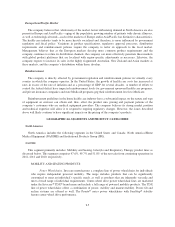Invacare 2012 Annual Report Download - page 21
Download and view the complete annual report
Please find page 21 of the 2012 Invacare annual report below. You can navigate through the pages in the report by either clicking on the pages listed below, or by using the keyword search tool below to find specific information within the annual report.company’s compliance with the quality system regulations. The certification audit is comprised of three distinct
reports, which the company expects will allow it to resume certain activities while it continues to bring the
remaining aspects of its quality systems into compliance. The three audit reports include:
• First, the third-party expert will inspect the qualification and validation procedures and documentation for
equipment and processes at the Taylor Street manufacturing facility. Once the FDA has reviewed the
report and notified the company that those procedures appear to be in compliance, which may or may not
require an FDA inspection, the company will be permitted to resume the manufacturing of components
and parts in its Taylor Street facility for the further manufacture of devices produced by other Invacare
facilities.
• Second, the third-party expert will review the company’s design control systems at the corporate and
Taylor Street facilities. Once the FDA has reviewed the report and notified the company that the design
control systems appear to be in compliance, which may or may not require an FDA inspection, the
company will be able to resume design activities of wheelchairs and power beds at the impacted Elyria
facilities.
• The final inspection by the third-party expert will be a comprehensive review of the company’s
compliance with the FDA’s quality system regulations at the impacted Elyria facilities. This audit will be
followed by an FDA inspection. After receipt of a written notification from the FDA that the company
appears to be in compliance, the company may resume full operations at the corporate and Taylor Street
manufacturing facilities.
The first two of the three expert certification audits started in December 2012 and were still in progress at
the time of filing of this Annual Report on Form 10-K. See Item 1A. Risk Factors and Item 7. Management’s
Discussion and Analysis of Financial Condition and Results of Operations.
In addition, in December 2010, the company received a warning letter from the FDA related to quality
system processes and procedures at the company’s Sanford, Florida facility.
Over the past two years, most significantly in 2012, the company made a concerted effort to update and
implement a comprehensive portfolio of processes compliant with the FDA’s Quality System Regulation. These
processes will be standardized across all of the company’s FDA registered facilities. Also, the company has
reorganized its quality assurance and regulatory affairs functions, including the addition of a senior vice president
of quality assurance and regulatory affairs with experience in the medical device industry who leads these
functions. See Item 1A. Risk Factors.
From time to time, the company may undertake voluntary recalls or field corrective actions of the
company’s products to correct product issues that may arise. These actions help to maintain ongoing customer
relationships and enhance the company’s reputation for adhering to high standards of quality and safety. None of
the company’s actions has been classified by the FDA as high risk. The company continues to strengthen its
programs to better ensure compliance with applicable regulations and actively keeps abreast of proposed
regulations, particularly those which could have a material adverse effect on the company.
The company occasionally sponsors scientific studies, usually involving its respiratory therapy products.
These studies have historically been bench studies using situation models to validate and compare device
performance against competitive products. Such studies have been published as abstracts and/or manuscripts in
peer reviewed science journals.
The 2010 health care reform law in the U.S., the Patient Protection and Affordable Care Act (Affordable
Care Act), included a number of provisions affecting the HME industry. In addition to expanding the Medicare
National Competitive Bidding program from 70 to 91 geographic bid areas, Medicare now makes rental
I-15
























